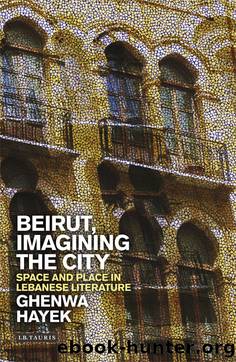Beirut, Imagining the City: Space and Place in Lebanese Literature by Ghenwa Hayek

Author:Ghenwa Hayek [Hayek, Ghenwa]
Language: eng
Format: epub
Tags: Literary Criticism, Middle Eastern, Middle East, History, General
ISBN: 9780857725325
Google: 5-eKDwAAQBAJ
Goodreads: 22929422
Publisher: I. B. Tauris
Published: 2014-10-29T06:36:40+00:00
Between Memory and History
In Family Frames: Photography, Narrative, and Postmemory, Marianne Hirsch introduces the concept of postmemory to describe a particular sort of memory, âdistinguished from memory by generational distance and from history by deep personal connectionâ.24 Hirsch elaborates further, saying that âpostmemory characterizes the experience of those who grew up dominated by narratives that preceded their birth, whose own belated stories are evacuated by the stories of the previous generation shaped by traumatic events that can be neither understood nor recreatedâ.25 Hirsch herself is particularly interested in the children of Holocaust survivors and their relationship to photographs of that experience, but admits that the term âmay usefully describe other second-generation memories of cultural or collective traumatic events and experiencesâ.26 I believe that Hirschâs notion of postmemory is a useful and productive one for thinking about the position of the young generation of Lebanese writers that emerged in the decade after the civil warâs end. After all, they grew up in the shadow of the collective trauma of war and the narratives of human and urban loss that it engendered. Yet, as I have already pointed out, they are separated from personal memories of the city by âgenerational distanceâ; still, they are invested in the urban space by more than a sense of history: they are interested in it as a heavily symbolic space in their nationâs collective imaginary.
By far the most interesting thing about how Hirschâs definition of postmemory relates to these second-generation novels is its relationship to acts of imaginative creation, such as fiction. For Hirsch, postmemory necessitates a creative intervention in history, since âits connection to its object or source is mediated not through recollection but through an imaginative investment and creationâ.27 The relationship of Jaberâs and Najjarâs novels to the city of Beirut is constructed through an imaginative act that lies between history and personal memory, which blurs the relationships between fiction and history.
In Writing History as a Prophet: Postmodernist Innovations of the Historical Novel, Elizabeth Wesseling argues that one of the focal ways in which the modernist and post-modernist historical novel differs from classical historical fiction is in the formerâs disruption of traditional narrative patterns through the inclusion of âan additional narrative level, situated between the represented past and the primary narratorâ.28 This produces what Wesseling describes as a âself-reflexiveâ attitude towards the writing of history, in which a mediating figure â in this case, a young writer â is placed between the events and their narrator. Moreover, this young writer figure often expresses an anxiety about, and unease with, the practice of history.29 As a result, the transmission of historical memory is placed in a mise-en-abîme that allows the narrative to expose the multiple layers of knowledge that undergird history. Each of the novels in this chapter complicates the relationship between historical narrative and fiction by exposing the tenuous divide between historical and fictional narrative, what Wesseling describes as the âborderland between fiction and historiographyâ.30 To varying degrees, Najjar and Jaber âmake the production
Download
This site does not store any files on its server. We only index and link to content provided by other sites. Please contact the content providers to delete copyright contents if any and email us, we'll remove relevant links or contents immediately.
| Bahrain | Egypt |
| Iran | Iraq |
| Israel & Palestine | Jordan |
| Kuwait | Lebanon |
| Oman | Qatar |
| Saudi Arabia | Syria |
| Turkey | United Arab Emirates |
| Yemen |
Empire of the Sikhs by Patwant Singh(22977)
The Wind in My Hair by Masih Alinejad(5034)
Rise and Kill First by Ronen Bergman(4705)
The Templars by Dan Jones(4629)
The Rape of Nanking by Iris Chang(4139)
12 Strong by Doug Stanton(3509)
Blood and Sand by Alex Von Tunzelmann(3140)
Babylon's Ark by Lawrence Anthony(2622)
The History of Jihad: From Muhammad to ISIS by Spencer Robert(2573)
No Room for Small Dreams by Shimon Peres(2320)
The Turkish Psychedelic Explosion by Daniel Spicer(2314)
Gideon's Spies: The Secret History of the Mossad by Gordon Thomas(2305)
Inside the Middle East by Avi Melamed(2305)
Arabs by Eugene Rogan(2262)
The First Muslim The Story of Muhammad by Lesley Hazleton(2219)
Come, Tell Me How You Live by Mallowan Agatha Christie(2212)
Bus on Jaffa Road by Mike Kelly(2104)
Kabul 1841-42: Battle Story by Edmund Yorke(1986)
1453 by Roger Crowley(1967)
